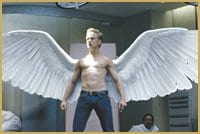What a disappointment. Despite all the hype, all the promise that X-Men: The Last Stand would unflinchingly delve into the question of mutants and how best to deal with difference in society, the film falls flat.
Until now, X-Men’s biggest success, be it on screen or on paper, has been its deft management of the comics’ political and philosophical themes of oppression, resistance and diversity.
The first two films largely captured the spirit of the X-Men concept with plots centred on human persecution of mutants and human paranoia that mutants can live among them undetected.
The parallels to queerness are unmistakable. Like mutants, queers are ‘born different’ and can hide among straights with varying degrees of success. Like mutants, queers also face discrimination and harassment because they are different and somehow considered a threat.
The last X-Men movie even featured a lengthy coming out scene, where Iceman finally told his family he’s a mutant.
It’s no surprise, then, that the X-Men resonate with those of us who have been marginalised by society, says Phil Jimenez, an openly gay artist who drew New X-Men in 2003.
“It’s basically a metaphor for oppression and various–isms: racism, homophobia, etc,” Jimenez explains. “I think many people read into it what they choose and that’s ultimately its great strength.”
“The fact that the X-Men are different and can’t help that difference, and they’ve had to grow up with that difference in relation to society, is a part of what makes the X-Men so appealing,” agrees Mike Marts, the editor responsible for Marvel Comics’ X-Men line of books.
That’s why the latest installment in the movie series had such promise.
X2 left off with mutant-human relations beginning to thaw and the US President appealing for peace on both sides. As we pick up in X3, the US government has even established a Department of Mutant Affairs and a mutant-human liaison as part of the cabinet.
Things appear to be looking up for mutants until a pharmaceutical company announces that it has discovered a cure for mutation, which it intends to market to mutants who want to become “normal” humans.
The implications of such a cure are huge.
Supporting a cure not only implies that mutants are a disease, but it could wipe them out as a group by eliminating the one thing they have in common. It even bears a striking similarity to the ex-gay movement, which promises to teach gays how to reject their homo tendencies and become straight.
On the other hand, who are the X-Men to deny such a cure to those mutants who seek it?
Should Rogue (Anna Paquin), be forced to live in emotional and mental anguish because of her uncontrollable powers that kill anyone she touches? Isn’t the right to medical treatment to alter one’s body one of the fundamentals of trans rights and the pro-choice lobby? And what about the intentionally dangerous mutants who could be stopped by such a cure?
The complexities of the issue are why it’s been at the centre of about a dozen stories in the X-Men’s 40 years as a comic book and cartoon property.
Unfortunately, the film dodges all of these issues.
Granted, the wonderfully camp villain Magneto (played by a scene-stealing Sir Ian McKellen) and his allies stand firmly against even the notion of a cure and do their best to destroy it. As Magneto tells his troops: “They mean to cure us. But we will show them that we are the cure.”
But the X-Men largely avoid defining their position on the problem at all. Though a number of characters express reservations about a cure, their single-minded mission to stop Magneto leaves no room for the possibility that he might be right.
Which is a shame because the opening half of the film promises a story that will be even better than the previous installments, with snappy dialogue, tense drama, and subtle jabs at almost every major issue in American politics. In one of the first scenes, the US president is told that Magneto was last seen in Montreal but was lost entering the country, referencing border security concerns in Washington. In a later scene, protests and violence outside mutant cure clinics are reminiscent of the reawakening abortion debate in the US.
The film also treats queer viewers to a number of subtle jokes on sexuality, including one scene where Beast (Kelsey Grammer) tells Storm (Halle Berry) that he loves what she’s done with her hair–perhaps a recurring joke from a similar line by Magneto in X2. In another scene, where Professor X (Patrick Stewart) leads an ethics class, he gives a nod to anyone looking for queer subtexts when he quips, “Einstein wasn’t a mutant–so far as we know.”
All of which makes the eventual third act catastrophe–where the X-Men rush off to fight Magneto without weighing and articulating the moral implications of their actions–all the more disappointing. The X-Men take their last stand but it’s never really clear what they’re standing for.
A queer history of X-Men
X-Men #14 (November 1965): The X-Men fight government-built Sentinel robots, charged with protecting the human race from mutants. This story marks the first example of government persecution of mutants.
X-Men #130 (February 1980): Nightcrawler refuses to use an “image inducer” that Professor X gives him to hide his demonic appearance from others. As he puts it, “God or fate or dumb luck made me what I am, and I won’t hide anymore, not even for the X-Men.”
New Mutants #45 (November 1985): When bullies threaten to out a student at a local high school as a mutant, he takes his own life rather than face them. Delivering his eulogy, Kitty Pride compares hatred of mutants explicitly to racism and homophobia, marking the first time homosexuality is mentioned in an X-Men comic.
Uncanny X-Men #256 (December 1989): Destiny and Mystique drop the first hints that they are in a relationship. They won’t be officially confirmed as a lesbian couple until X-Men Forever #5 (2001).
Alpha Flight #106 (January 1991): Northstar outs himself, becoming the first mainstream gay superhero.
X-Force #118 (July 2001): Before going on his first mission, new member Bloke kisses his boyfriend, offering the first same-sex kiss in a Marvel Comic.
Uncanny X-Men #414 (October 2002): Northstar joins the X-Men.
X-Force #129 (June 2003): Phat and Vivisector are shown lying in bed after having sex. To date, this is the most explicit reference to gay sex shown in a Marvel Comic.
New Mutants #4 (September 2003): Karma, a teacher at Xavier’s school, officially outs herself as a lesbian, confirming years of suspicion.
Ultimate X-Men #65 (November 2005): Ultimate Colossus finally comes out to his fellow X-Men after years of hints, including an apparent crush on Ultimate Wolverine and repeatedly flirting with Ultimate Northstar.


 Why you can trust Xtra
Why you can trust Xtra


